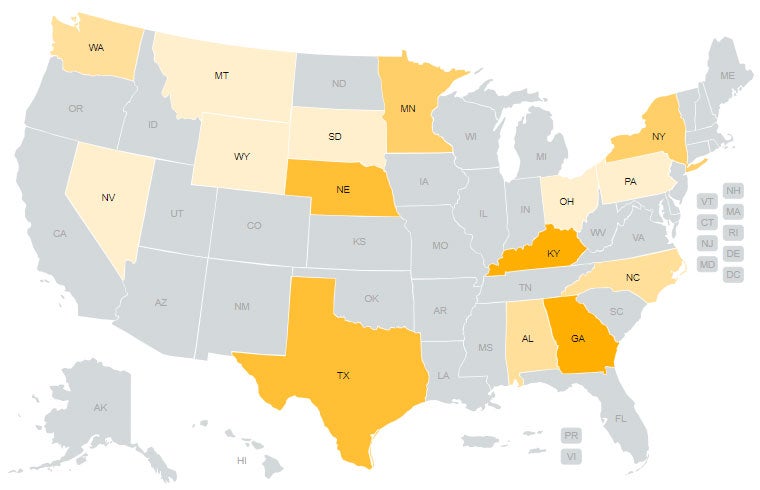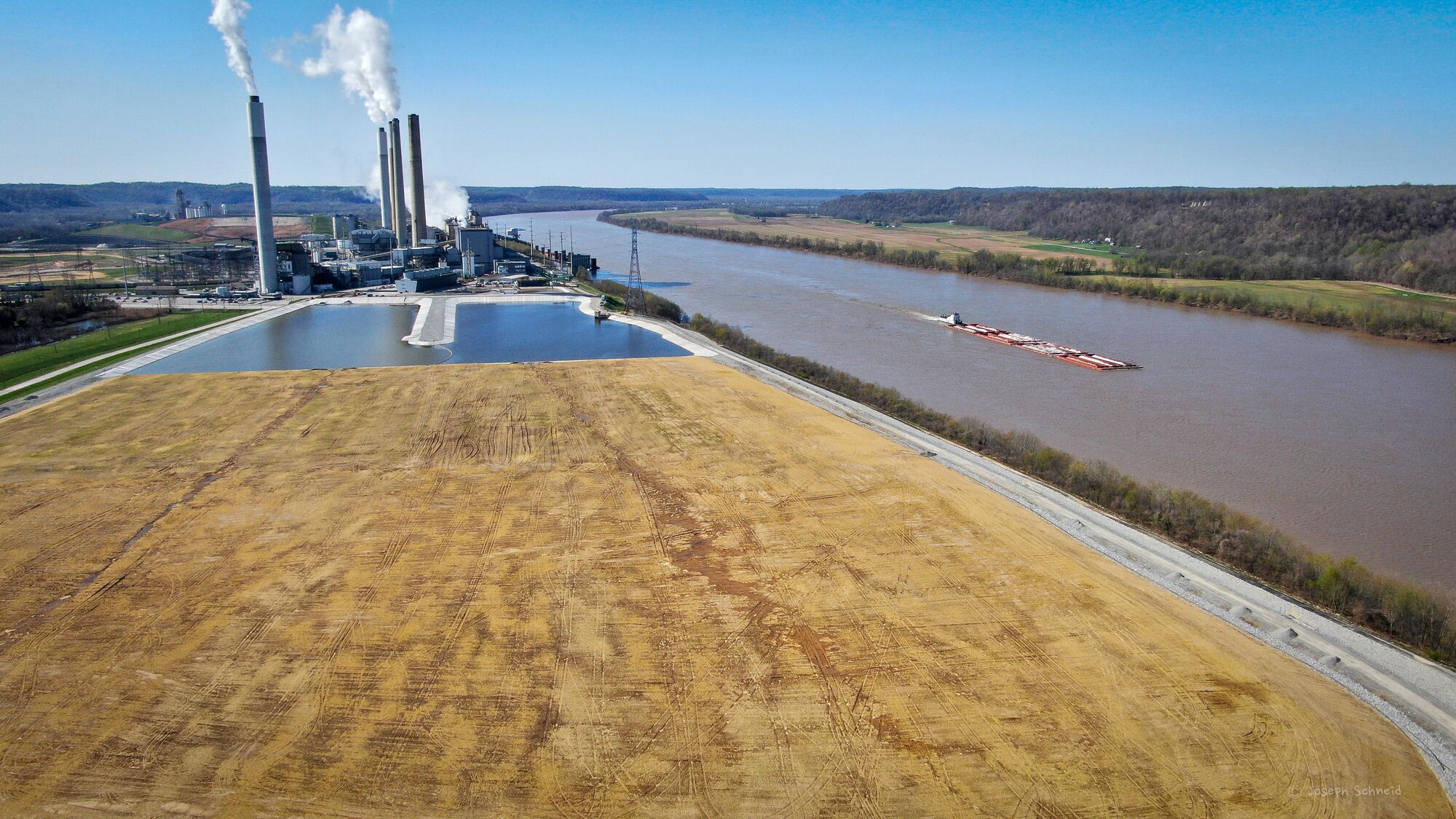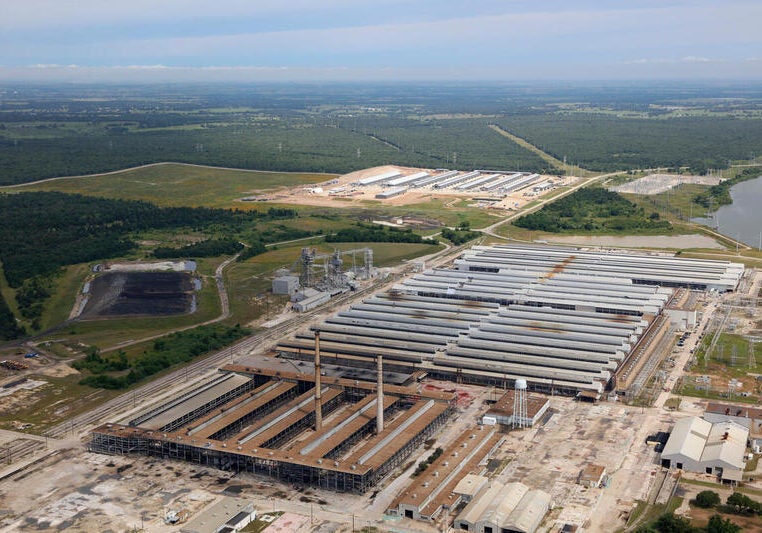The Impacts of Cryptomining
September 12, 2023
Cryptocurrency Mining in Kentucky
Kentucky is among the top states for cryptomining.
Kentucky produces more carbon dioxide pollution from cryptocurrency mining than any other U.S. state.
On this Page
Proof-of-work cryptocurrency mining, which is designed to consume enormous quantities of energy, effectively entails millions of computing machines racing to solve a complex, but meaningless, problem. As more mining machines enter the race, the difficulty of the computational problem gets harder, and the electricity required to win increases exponentially.
After cryptocurrency mining was banned in China in 2021, the number of mining operations exploded in the United States. It is estimated that 38% of Bitcoin globally is mined in the U.S. Top-down estimates of the electricity consumption of cryptocurrency mining in the U.S. imply that the industry was responsible for an excess 27.4 million tons of carbon dioxide (CO2) between mid-2021 and 2022.
In 2022, Kentucky was home to nearly 20% of the collective computing power of the country’s proof-of-work mining operations. The growth of cryptomining threatens to keep polluting coal power plants active, strain the grid, and raise electricity rates for Kentuckians.

In 2021, Bitcoin mining operations emitted an estimated 15.1 megatons of CO2 pollution in the United States.
Kentucky leads all states in CO2 pollution from cryptomining, as of Aug. 2021. Fifteen states are responsible for more than 90% of the estimated 15.1 megaton carbon footprint of the Bitcoin network in the United States. (Source: Joule)
Kentucky produces more carbon dioxide pollution from cryptocurrency mining than any other U.S. state, and has the second highest carbon intensity for crypto of any state.
Kentucky’s carbon footprint from cryptocurrency mining is estimated at 3.3 megatons of carbon dioxide per year, because approximately 70% of Kentucky’s power came from burning coal, according to government data. Coal-powered electricity has numerous and severe health impacts from air and water pollution and is an enormous driver of greenhouse gas pollution.

Electricity for Cryptocurrency Mining in the U.S.
Cryptocurrency miners procure their electricity in four different ways:
1
Outright purchase of power plants that supply mining rigs “behind-the-meter”
2
Power purchase agreements with power generators or utilities
3
Electricity purchases from a local utility
4
By burning fossil gas at oil and gas wells
While proof-of-work mining proponents claim that cryptocurrency mining often looks for the cleanest energy, the industry in fact often seeks readily-available cheap energy and minimal regulation, which can result in re-starting defunct coal and gas plants, as well as cancelling or significantly delaying the closure of power plants scheduled to retire.
Tracking cryptocurrency mining in the United States is difficult. The industry is notoriously opaque, and little-to-no reporting requirements exist at either the state or federal level. The most reliable sources of information are a patchwork of filings before the Securities and Exchange Commission (SEC) by publicly traded cryptocurrency companies, environmental permit applications, utility and other energy filings, and local reporting.


Cryptomining Will Drive Up Costs for Everyone Else in Kentucky
The growth of cryptocurrency mining in Kentucky threatens to drive up costs for other utility customers. In Kentucky, cryptomining facilities benefit from discounted electricity rates and tax incentives that will ultimately be passed onto other customers. Kentucky utilities pay millions for any upgrades to the grid to serve crypto mines. In some cases, there may not be enough power generated locally to power cryptocurrency mines, so the utility would need to buy additional electricity from the market. These costs are often shared by other customers of the utilities, who are already often paying higher rates than cryptomining companies.
There is ample evidence of utilities expending significant sums to serve cryptocurrency mining operations — costs that will be passed on as higher rates to the utility’s other customers.
For example, the Kentucky Public Service Commission approved $12.7 million in transmission upgrades for Big Rivers Electric to provide service to Blockware Mining in Paducah, and other customers may share those costs.
These investments are often made instead of long-overdue transmission upgrades that would benefit ordinary ratepayers.
An op-ed by Josh Bills from Mountain Association highlights the risk to ratepayers, given “cryptomining facilities include banks of computers, and seek cheap energy” which could lead to utility bills skyrocketing based on the size of the operation.

Crypto Miners in Kentucky Get Deep Discounts on Electricity Rates But Do Not Deliver Jobs
Kentucky state law permits electric utilities to offer Economic Development Rates to energy-intensive proof-of-work cryptocurrency mining operations although the operations consist mainly of rows of mining machines that need little monitoring, with minimal jobs or community benefits.
Public interest organizations, Kentucky’s Attorney General, and industrial utility customers have opposed proposals to give some cryptomining companies subsidized power rates because of the negative impacts on other customers. For example:
Crypto Subsidies Can Lead to Rate Increases
Kentucky Power asked the Kentucky Public Service Commission to approve massive discounts for crypto mining companies, even though Kentucky Power admitted that it doesn’t have enough generating capacity to serve its existing customers and would need to buy electricity from the market, costs that other customers will share.
This is coming at a time when Kentucky Power has proposed a whopping 18% rate increase for residential customers in June 2023.
The Commission recently denied one such request for discounted rates for a large, 250 MW cryptomining facility in Louisa, Kentucky, citing concerns that it could raise costs significantly for other Kentucky Power customers.
$4M in Subsidized Rates for a Bitcoin Facility
In August 2023, the Kentucky Public Service Commission approved a request from Kentucky Utilities to provide more than $4 million in subsidized rates for a 13 MW Bitcoin mining facility which says it will create up to five jobs.
But the facility was up and running well before the rates were approved, calling into question whether there is any need for subsidies.
Limited economic development incentives available should be reserved for companies where there is evidence the subsidies will create additional jobs. Earthjustice argues against contracts that benefit cryptocurrency miners rather than local communities. Kentucky’s Economic Development Rate contracts should include require guarantees that jobs will be created.
Tax Incentives for Cryptomining in Kentucky
The Kentucky state government offers enormous tax incentives to this industry, which have been estimated to cost Kentucky taxpayers millions of dollars per year in lost tax revenue.
These tax incentives include tax exemptions on mining equipment, tax exemptions on electricity consumed, sales-tax refunds on mining equipment, tax incentives on income taxes and wage assessments; and income tax and limited liability entity tax credits.
The Kentucky Center for Economic Policy argues that incentivizing the industry so heavily is a poor use of government funds because, among other reasons, it is an industry that creates little local work.
As a recent article examining the impacts of cryptocurrency mining in Kentucky described, “[s]ome see echoes of what they say were the worst elements of the now largely defunct coal industry: out-of-state money, absentee owners, and huge fortunes made with little wealth trickling down to local communities.”
Cryptocurrency Mining Operations Pose Damaging Impacts on Local Communities
Local Air Pollution
Cryptocurrency mining that relies on fossil fuel combustion for energy generation increases the air pollution impacts of the underlying combustion method.
For coal combustion, this means fine particles, sulfur dioxide, nitrogen oxides, and air toxics; for gas, the biggest air pollution impact is typically nitrogen oxides.
Air pollution is one of the biggest environmental threats to public health. Air pollution exposure, especially to particulate matter, is estimated to cause 7 million premature global deaths annually.
Noise Pollution
Crypto mines create significant noise pollution that can negatively impact local residents and wildlife. Many crypto mines use high-velocity fans to cool their banks of computers which creates significant round-the-clock noise.
Electronic and Other Solid Waste
The specialized machines used for cryptocurrency mining have a limited lifespan of just a few years, and are often replaced even faster than that as companies race to increase computing power.
A recent estimate found that in 2021 alone, proof-of-work mining generated as much e-waste as produced by the whole country of the Netherlands.
The massive energy consumption of proof-of-work cryptocurrency mining threatens to undermine decades of progress towards achieving climate goals, and threatens grids, utilities, communities, and ratepayers. Regulators and policymakers must take steps to reduce the harms of cryptocurrency mining. Learn more on cryptocurrency.
Earthjustice’s Clean Energy Program uses the power of the law and the strength of partnership to accelerate the transition to 100% clean energy.